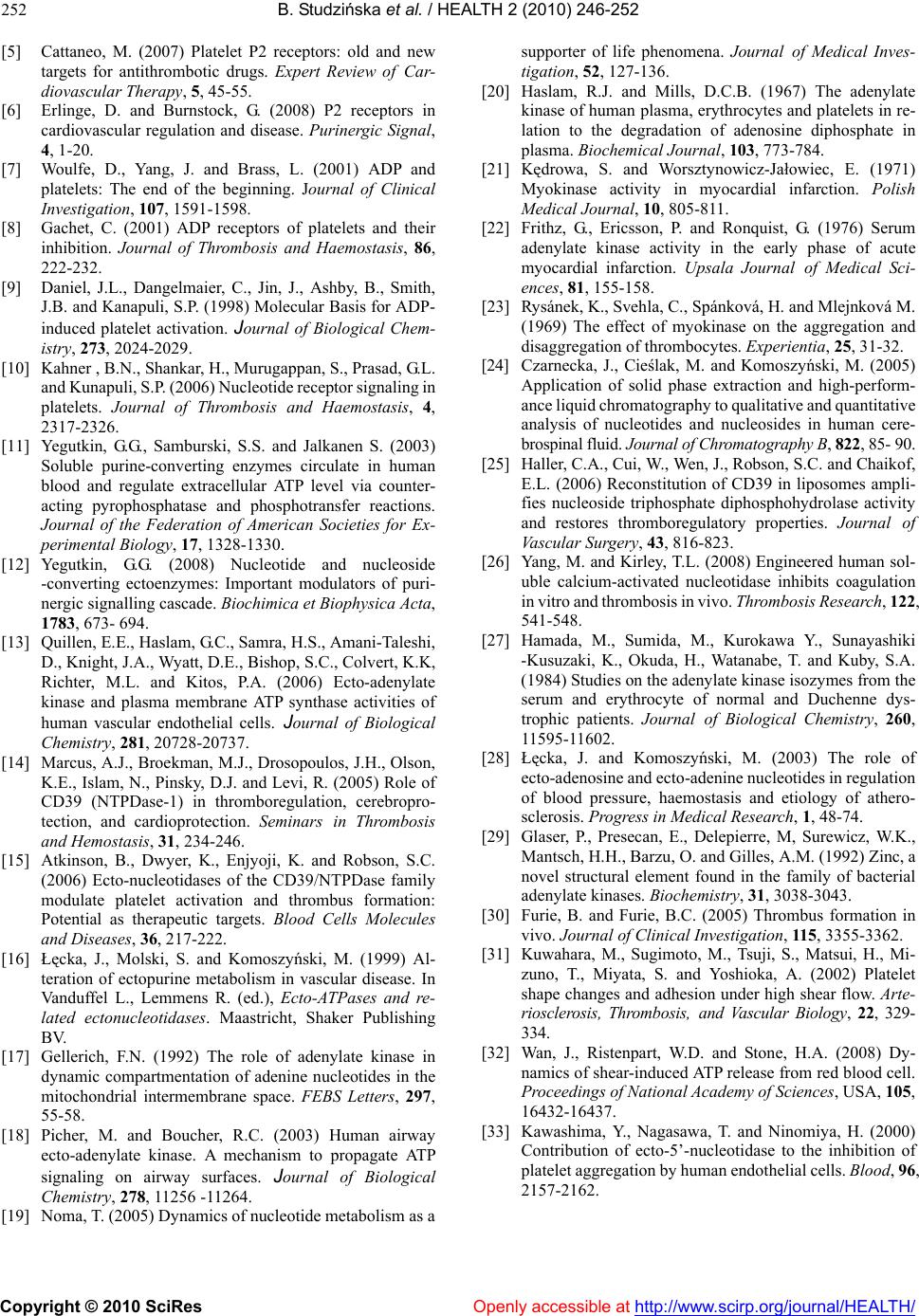
B. Studzińska et al. / HEALTH 2 (2010) 246-252
Copyright © 2010 SciRes http://www.scirp.org/journal/HEALTH/Openly accessible at
252
[5] Cattaneo, M. (2007) Platelet P2 receptors: old and new
targets for antithrombotic drugs. Expert Review of Car-
diovascular Therapy, 5, 45-55.
[6] Erlinge, D. and Burnstock, G. (2008) P2 receptors in
cardiovascular regulation and disease. Purinergic Signal,
4, 1-20.
[7] Woulfe, D., Yang, J. and Brass, L. (2001) ADP and
platelets: The end of the beginning. Journal of Clinical
Investigation, 107, 1591-1598.
[8] Gachet, C. (2001) ADP receptors of platelets and their
inhibition. Journal of Thrombosis and Haemostasis, 86,
222-232.
[9] Daniel, J.L., Dangelmaier, C., Jin, J., Ashby, B., Smith,
J.B. and Kanapuli, S.P. (1998) Molecular Basis for ADP-
induced platelet activation. Journal of Biological Chem-
istry, 273, 2024-2029.
[10] Kahner , B.N., Shankar, H., Murugappan, S., Prasad, G.L.
and Kunapuli, S.P. (2006) Nucleotide receptor sign aling in
platelets. Journal of Thrombosis and Haemostasis, 4,
2317-2326.
[11] Yegutkin, G.G., Samburski, S.S. and Jalkanen S. (2003)
Soluble purine-converting enzymes circulate in human
blood and regulate extracellular ATP level via counter-
acting pyrophosphatase and phosphotransfer reactions.
Journal of the Federation of American Societies for Ex-
perimental Biology, 17, 1328-1330.
[12] Yegutkin, G.G. (2008) Nucleotide and nucleoside
-converting ectoenzymes: Important modulators of puri-
nergic signalling cascade. Biochimica et Biophysica Acta,
1783, 673- 694.
[13] Quillen, E.E., Haslam, G.C., Samra, H.S., Amani-Taleshi,
D., Knight, J.A., Wyatt, D.E., Bishop, S.C., Colvert, K.K,
Richter, M.L. and Kitos, P.A. (2006) Ecto-adenylate
kinase and plasma membrane ATP synthase activities of
human vascular endothelial cells. Journal of Biological
Chemistry, 281, 20728-20737.
[14] Marcus, A.J., Broekman, M.J., Drosopoulos, J.H., Olson,
K.E., Islam, N., Pinsky, D.J. and Levi, R. (2005) Role of
CD39 (NTPDase-1) in thromboregulation, cerebropro-
tection, and cardioprotection. Seminars in Thrombosis
and Hemostasis, 31, 234-246.
[15] Atkinson, B., Dwyer, K., Enjyoji, K. and Robson, S.C.
(2006) Ecto-nucleotidases of the CD39/NTPDase family
modulate platelet activation and thrombus formation:
Potential as therapeutic targets. Blood Cells Molecules
and Diseases, 36, 217-222.
[16] Łęcka, J., Molski, S. and Komoszyński, M. (1999) Al-
teration of ectopurine metabolism in vascular disease. In
Vanduffel L., Lemmens R. (ed.), Ecto-ATPases and re-
lated ectonucleotidases. Maastricht, Shaker Publishing
BV.
[17] Gellerich, F.N. (1992) The role of adenylate kinase in
dynamic compartmentation of adenine nucleotides in the
mitochondrial intermembrane space. FEBS Letters, 297,
55-58.
[18] Picher, M. and Boucher, R.C. (2003) Human airway
ecto-adenylate kinase. A mechanism to propagate ATP
signaling on airway surfaces. Journal of Biological
Chemistry, 278, 11256 -11264.
[19] Noma, T. (2005) Dynamics of nucleotide metabolism as a
supporter of life phenomena. Journal of Medical Inves-
tigation, 52, 127-136.
[20] Haslam, R.J. and Mills, D.C.B. (1967) The adenylate
kinase of human plasma, erythrocytes and platelets in re-
lation to the degradation of adenosine diphosphate in
plasma. Biochemical Journal, 103 , 773-784.
[21] Kędrowa, S. and Worsztynowicz-Jałowiec, E. (1971)
Myokinase activity in myocardial infarction. Polish
Medical Journal, 10, 805-811.
[22] Frithz, G., Ericsson, P. and Ronquist, G. (1976) Serum
adenylate kinase activity in the early phase of acute
myocardial infarction. Upsala Journal of Medical Sci-
ences, 81, 155-158.
[23] Rysánek, K., Svehla, C., Spánková, H. and Mlejnková M.
(1969) The effect of myokinase on the aggregation and
disaggregation of thrombocytes. Experientia, 25, 31-32.
[24] Czarnecka, J., Cieślak, M. and Komoszyński, M. (2005)
Application of solid phase extraction and high-perform-
ance liqu id chroma tography to q ualitative and quantit ative
analysis of nucleotides and nucleosides in human cere-
brospinal fluid. Journal of Chromatography B, 822, 85- 90.
[25] Haller, C.A., Cui, W., Wen, J., Robson, S.C. and Chaikof,
E.L. (2006) Reconstitution of CD39 in liposomes ampli-
fies nucleoside triphosphate diphosphohydrolase activity
and restores thromboregulatory properties. Journal of
Vascular Surgery, 43, 816-823.
[26] Yang, M. and Kirley, T.L. (2008) Engineered human sol-
uble calcium-activated nucleotidase inhibits coagulation
in vitro and thrombosis in vivo. T hr ombosis Resear ch, 122,
541-548.
[27] Hamada, M., Sumida, M., Kurokawa Y., Sunayashiki
-Kusuzaki, K., Okuda, H., Watanabe, T. and Kuby, S.A.
(1984) Studies on the adenylate kinase isozymes from the
serum and erythrocyte of normal and Duchenne dys-
trophic patients. Journal of Biological Chemistry, 260,
11595-11602.
[28] Łęcka, J. and Komoszyński, M. (2003) The role of
ecto-aden osine a nd ect o-a denin e nucleo ti des i n r egul ation
of blood pressure, haemostasis and etiology of athero-
sclerosis. Progress in Medical Research, 1, 48-74.
[29] Glaser, P., Presecan, E., Delepierre, M, Surewicz, W.K.,
Mantsch, H.H., Barzu, O. and Gilles, A.M. (1992) Zinc, a
novel structural element found in the family of bacterial
adenylate kinases. Biochemistry, 31, 3038-3043.
[30] Furie, B. and Furie, B.C. (2005) Thrombus formation in
vivo. Journal of Clinical Investigation, 115 , 3355-3362.
[31] Kuwahara, M., Sugimoto, M., Tsuji, S., Matsui, H., Mi-
zuno, T., Miyata, S. and Yoshioka, A. (2002) Platelet
shape changes and adhesion under high shear flow. Arte-
riosclerosis, Thrombosis, and Vascular Biology, 22, 329-
334.
[32] Wan, J., Ristenpart, W.D. and Stone, H.A. (2008) Dy-
namics of shear-induced ATP release from red blood cell.
Proceedings of National Academy of Sciences, USA, 105,
16432-16437.
[33] Kawashima, Y., Nagasawa, T. and Ninomiya, H. (2000)
Contribution of ecto-5’-nucleotidase to the inhibition of
platelet aggregat ion by human endothelial cells. Blood, 96,
2157-2162.